Expert's Rating
Pros
- Competitive price
- New fingerprint reader works as well as a camera
Cons
- Average performance
- USB-C hub may be needed for I/O expansion
Our Verdict
The Surface Laptop Go is Microsoft’s most accessible Surface yet, a very good budget laptop that can compete against other midrange models. Even compromises like its fingerprint reader and a sub-1080p screen surprisingly work.
Best Prices Today: Microsoft Surface Laptop Go
The Surface Laptop Go is Microsoft’s second try at an affordable Surface, and it hits the mark better than the original Surface Go tablet did. It still offers compromises, with strategic cuts to keep the price competitive with a Chromebook. Still, they’re mostly smart decisions—even a sub-1080p display and Windows 10 in S Mode didn’t turn us off. Although the Surface Laptop Go lacks the easy expansion of some competing laptops, it’s otherwise a solid budget offering.
Still, be picky in what you consider buying. We wouldn’t recommend the Surface Laptop Go’s minimum $549 configuration, but the middle $699 option (which we didn’t test) seems like the best bang for the buck. At $899, the 12.5-inch Surface Laptop Go review unit we tested bobs up to the very top of the “budget” category, though it shows off this new product at its best.
 Mark Hachman / IDG
Mark Hachman / IDG
This photo highlights how visually interesting the new Ice Blue finish is: in the right light, the chassis can look either metallic or tend toward blue.
Surface Laptop Go: Specs and features
- Display: 12.45-inch (1536×1024, 148 ppi, 330 nits rated) multitouch PixelSense display (Microsoft says there is no pen support.)
- Processor: Core i5-1035G1
- Graphics: UHD Graphics
- Memory: 4GB-8GB LPDDR4x (8GB as tested)
- Storage: 64GB eMMC, 128GB-256GB SSD (256GB SSD as tested)
- Ports: 1 USB-C, 1 USB-A, Surface Connect, 3.5mm audio jack
- Camera: 720p f2.0 (user-facing)
- Battery: 39.7Wh (design), 41Wh (full charge)
- Wireless: WiFi 6 (802.11ax), Bluetooth 5.0
- Operating system: Windows 10 Home in S Mode
- Dimensions (inches): 10.95 x 8.10 x 0.62 inches
- Weight: 2.45 pounds
- Chassis: Aluminum, with plastic resin
- Colors: Ice Blue, Sandstone, Platinum
- Price: Beginning at $549 (Microsoft)Remove non-product link, $899 as tested (Amazon)
Surface Laptop Go: Prices and configurations
All Surface Laptop Go models being selling October 13. Microsoft is offering overlapping configurations of the Surface Laptop Go for consumers, education, and business. The Business models upgrade the OS to Windows 10 Pro and offer (in supported markets) a $100 warranty service that includes expedited device replacement. Finally, Microsoft’s education channel offers an additional model not shown here.
- Core i5/4GB RAM/64GB SSD: $549 Consumer/Education (Platinum only)
- Core i5/8GB RAM/128GB SSD: $699 Consumer/Education, $799 Business
- Core i5/8GB RAM/256GB SSD: $899 Consumer/Education, $999 Business
- Core i5/16GB RAM/256GB SSD: $1,099 Education, $1,199 Business
While that $549 starting price is appealing, the basic Core i5/4GB RAM/64GB configuration should probably be passed over in favor of more powerful options. The $699 Core i5/8GB RAM/128GB SSD (which we haven’t tested) appears to offer the most value of all the Surface Laptop Go configuration, especially when paired with Microsoft’s OneDrive cloud storage.
It’s a better deal than our review unit, given the $200(!) premium Microsoft charges for an additional 128GB worth of storage. Unlike the Surface Pro X or Surface Laptop 3, the SSD does not appear to be user-accessible, leaving upgrades out of the picture.
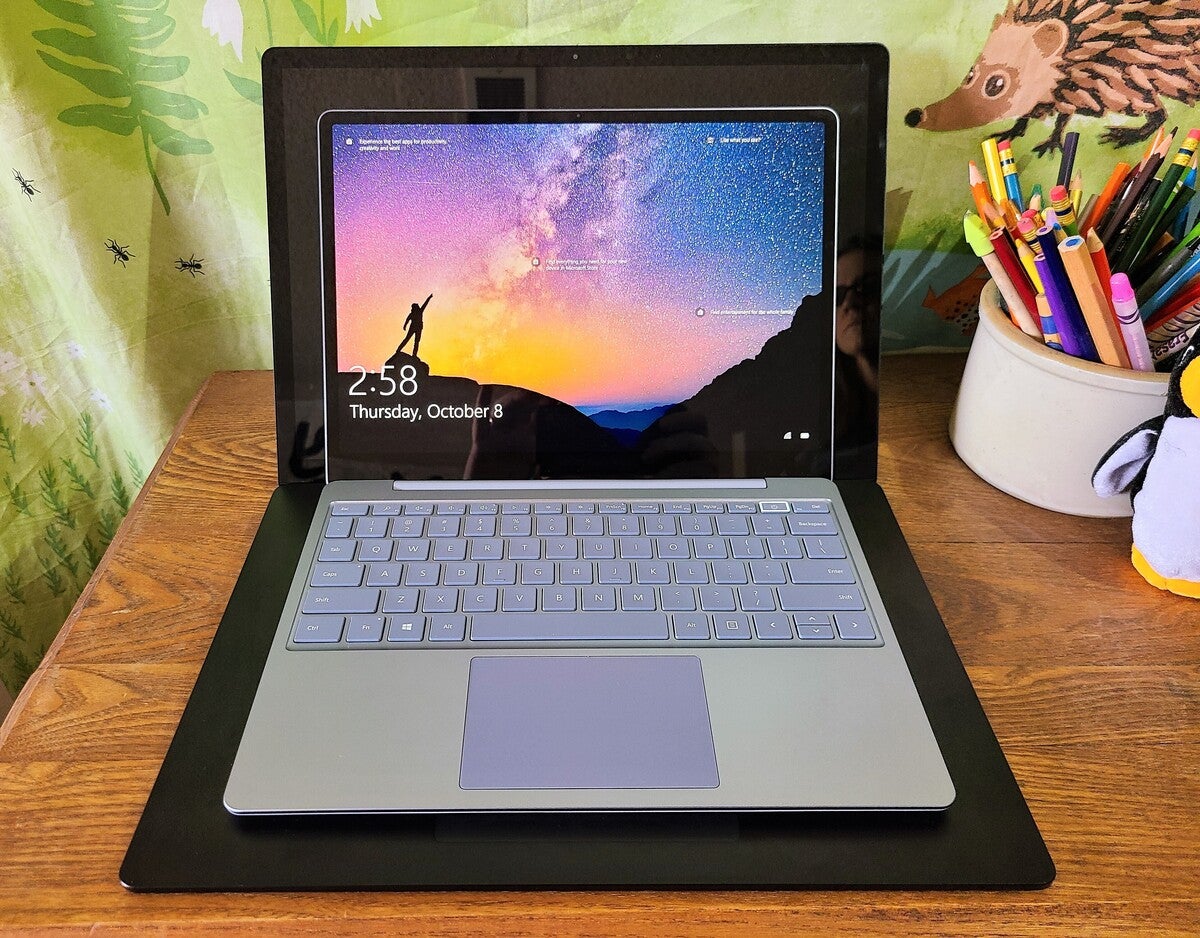 Mark Hachman / IDG
Mark Hachman / IDG
The Surface Laptop Go, nestled into the lap of the 15-inch Surface Laptop 3. My younger son uses Chromebooks, so what better place to show off the Surface Laptop Go than his desk?
Solid build quality
Our Surface Laptop Go review unit was the new Ice Blue configuration, which looks a lot less blue than Microsoft’s imagery would suggest. In fact, the chassis looks almost like the Sandstone color under the right light, but with a deeper blue paint coating the keyboard. The lid is made of anodized aluminum, but the keyboard deck and base are made of plastic resin, with 40 percent glass fiber and 30 percent post-consumer resin. It’s all designed to reduce weight while still maintaining rigidity.
If it matters, Microsoft is using a different paint on top of the plastic resin of the keyboard, which gives it a different feel. (More on that in a bit.) The Laptop Go reclines to about the same angle as the other Surface Laptops, or a comfortable 50 degrees off of the horizontal. At 2.45 pounds, it feels light and comfortable in the hand.
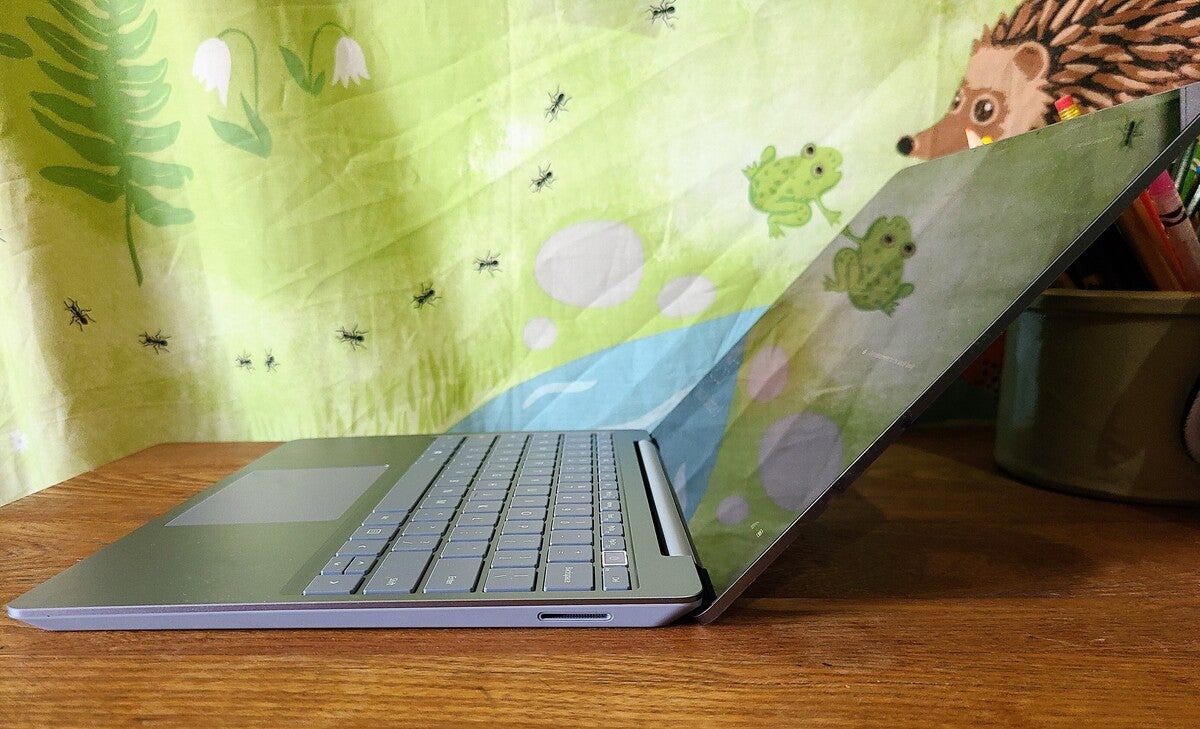 Mark Hachman / IDG
Mark Hachman / IDG
The Surface Laptop Go holds no surprises in terms of port layout: there’s a Surface Connector port on tie right side of the laptop…
The Surface Laptop Go isn’t afraid to spin up its fan, which is noticeable though not annoying, even in a quiet room. Other Surface Laptops pulled air in and then pushed it out through a hidden exhaust port in the hinge. Microsoft’s tweaked that, so that both the intake and the exhaust are hidden inside the hinge. I favor a brutalist approach—who cares what the bottom of a laptop looks like?—but perhaps Microsoft was worried about crumbs or dust. The Laptop Go doesn’t get hot, but it does stay warm for long periods.
One flaw Microsoft may want to take a look at: Microsoft uses a new, 39W charger for the Surface Laptop Go, which charges the laptop via the Surface Connector, as before. On my review unit, the connection was never loose, and there didn’t seem to be any schmutz inside the Surface Connector slot. However, the charger sometimes, even frequently, wouldn’t charge unless carefully inserted. (Fortunately there’s a charging LED on the connector itself to let you know something’s up.)
I reported the problem to Microsoft, then set the charger aside and used an older Surface charger instead once our benchmark testing completed. You can also charge the Surface Laptop Go directly through the USB-C port, or via a hub.
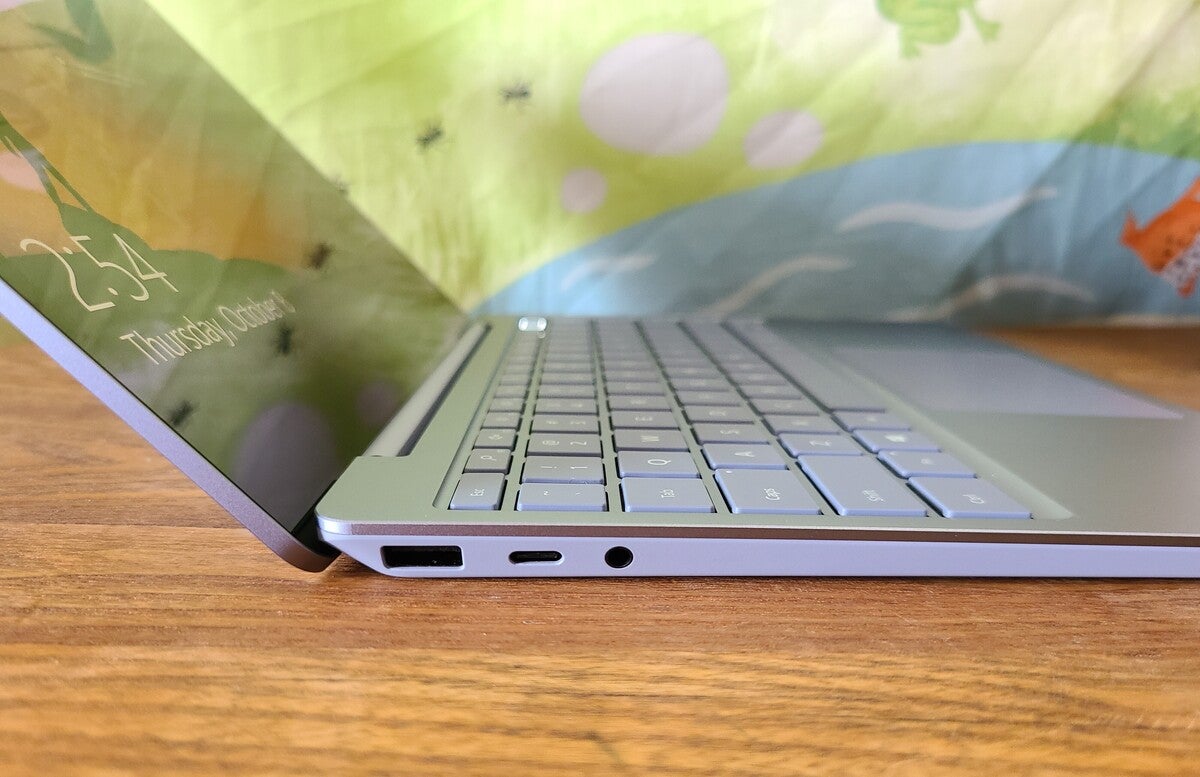 Mark Hachman / IDG
Mark Hachman / IDG
…and on the left, there’s a USB-A port, a USB-C port, and the headphone jack.
Two specific features distinguish the Surface Laptop Go from other Microsoft Surfaces, and from other laptops: the new fingerprint reader, and the Surface Laptop Go’s lower-res display. Let’s look at each.
Meet the new fingerprint reader
Microsoft helped usher in biometric identification with Windows Hello, and specifically its outstanding depth camera, which can recognize you and unlock your PC almost immediately. Some rival laptops have chosen Hello-certified fingerprint readers instead, either broad circular ones hidden under the power button (like the Huawei Matebook X Pro) or “strip” readers placed elsewhere on the device.
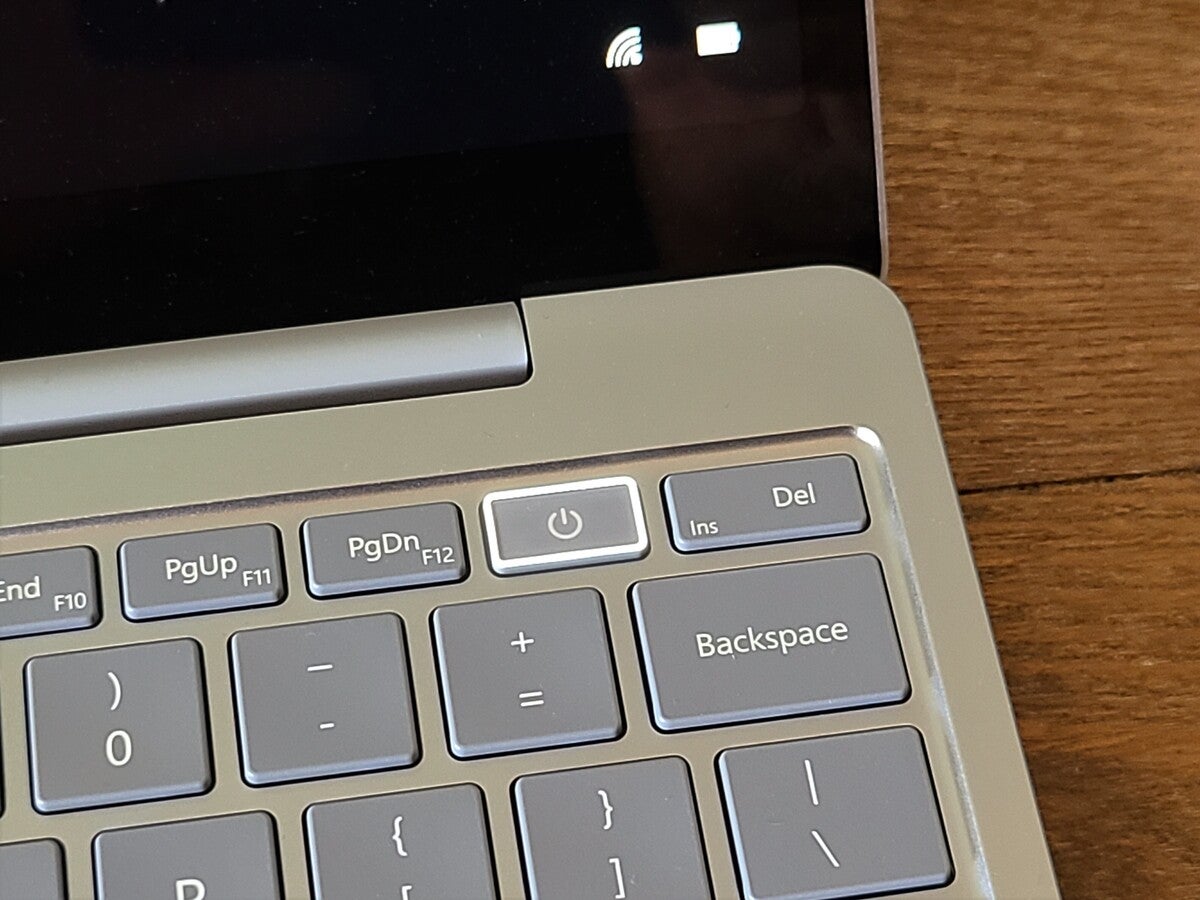 Mark Hachman / IDG
Mark Hachman / IDG
If the Surface Laptop Go is locked, the LED ring will light to guide your finger in for a landing. Maybe Microsoft’s Surface engineers took a cue from Flight Simulator?
The Surface Laptop Go combines the two, with the fingerprint reader hidden within the rectangular power button. When the laptop is locked, a somewhat gaudy LED ring outlines the power button, illuminating the landing pad. The reader worked very well, about as quick and accurate as a newly calibrated depth camera. It even asked me to move my finger when it wasn’t aligned correctly. The fingerprint reader stores your fingerprint long enough that you can depress the power button with your finger, remove it, and you’ll still be logged in once the Surface Laptop Go completes its short boot cycle.
Fingerprint readers can accumulate schmutz over time, just as depth cameras don’t recognize changes in my facial hair after I pull them from the shelf. On one occasion, the reader didn’t grant me access until I dried my hands. Still, Microsoft’s fingerprint experiment may turn out to be a smart play.
Is the Surface Laptop Go’s 1024p display worth it?
In our original report on the Surface Laptop Go, we immediately noted that its display resolution fell beneath the 1080p threshold that we consider acceptable for laptops with 14-inch or wider displays. The Laptop Go’s screen is a little smaller than that, so we wondered whether its resolution of 1536×1024 (148 ppi) would appear deficient to the naked eye.
The answer is yes…and no. Working on a 720p laptop is an unquestionably poor experience, but 1536×1024 (1,572,864 total pixels) is closer to 1920×1080 (2,073,600 pixels) than 1280×720 (921,600 pixels). Consider, too, that the Surface Laptop Go’s pixels-per-inch count is comparable to that of a budget 15-inch 1080p notebook, such as an Asus VivoBook.
In this section you’ll see photos of the Surface Laptop Go’s display, captured with the Samsung Galaxy S20+ camera in its 4:3 64MP mode. The images were captured at a distance of five inches, far less than a typical viewing distance of about two feet. Because of the different display sizes and scaling settings, the portion of the screen the camera captured doesn’t match up perfectly. Still, this should help provide some insight as to what it’s like working on the Surface Laptop Go.
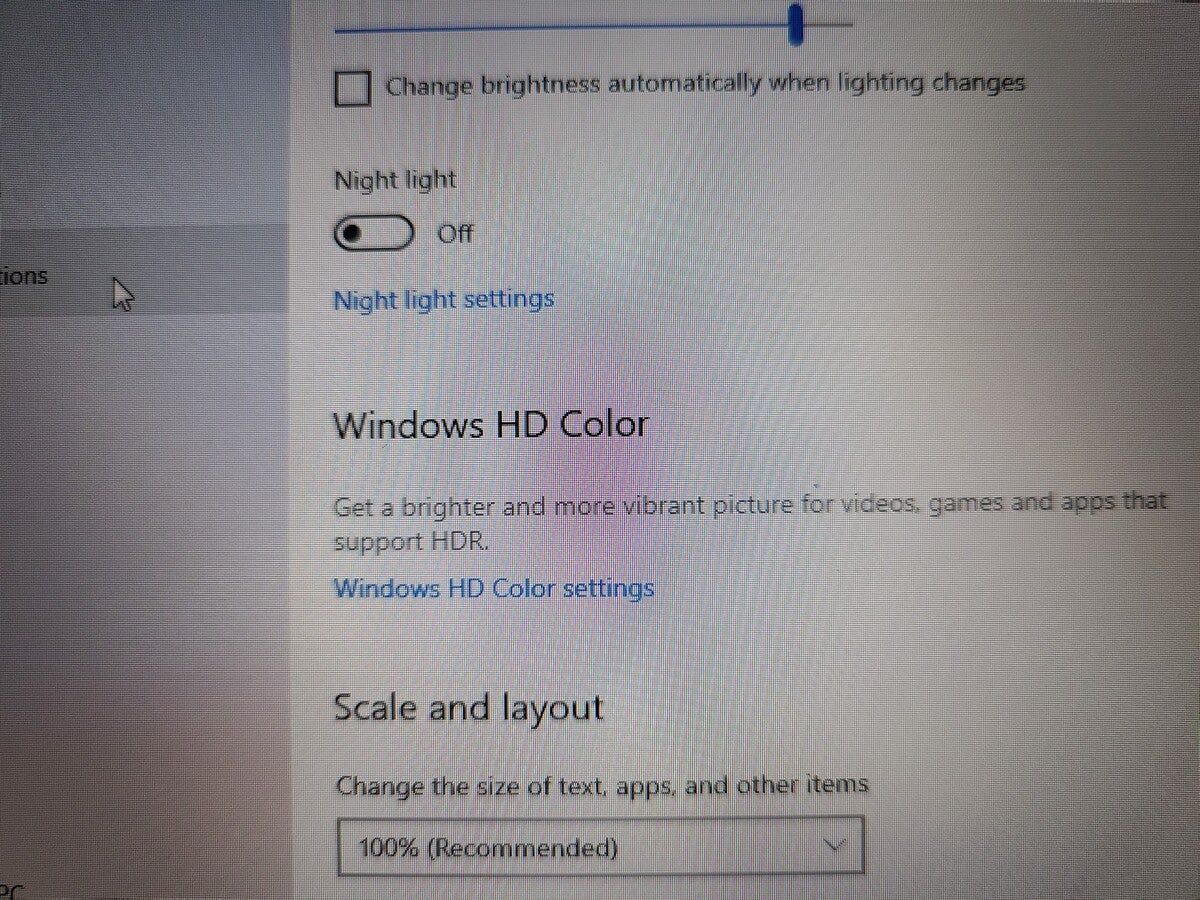 Mark Hachman / IDG
Mark Hachman / IDG
We shot high-resolution photos at a fixed distance of five inches of the Surface Laptop Go to offer some evidence of how its display compares visually. (Ignore the color anomalies and moire, as they don’t show up in the real world.) We’ve used Microsoft’s recommended scaling settings. Click the photo to zoom in for more detail.
This is the 12.45-inch Surface Laptop Go (1536×1024) at scaling of 100 percent.
While my eyes could never discern an individual pixel, there’s a palpable sense that you’re looking at a cloud of individual elements, like fog. The lower resolution slightly contradicts the smoothed curves of antialiased fonts, exposing their jagged edges. The downgrade is most apparent if you compare the display to that of a Surface Laptop or Surface Book.
Still, the Surface Laptop Go’s resolution is close enough to 1080p that the differences never became annoying, especially when interacting with text. It’s when you start throwing more pixels at the display—higher-resolution images, say, or 1080p video—that the deficiencies become more pronounced. (The Surface Laptop Go’s display is rated at 330 nits, which is somewhat above the brightness level we consider comfortable for working on a laptop and a mark in its favor.) In part, that may be because a Surface display is typically colorful and vibrant; it’s color-calibrated at the factory. Our 4K/60-fps YouTube test video looked good—though YouTube was only sending down a 1536×864 viewport because of the Surface Laptop Go’s smaller, lower-res display.
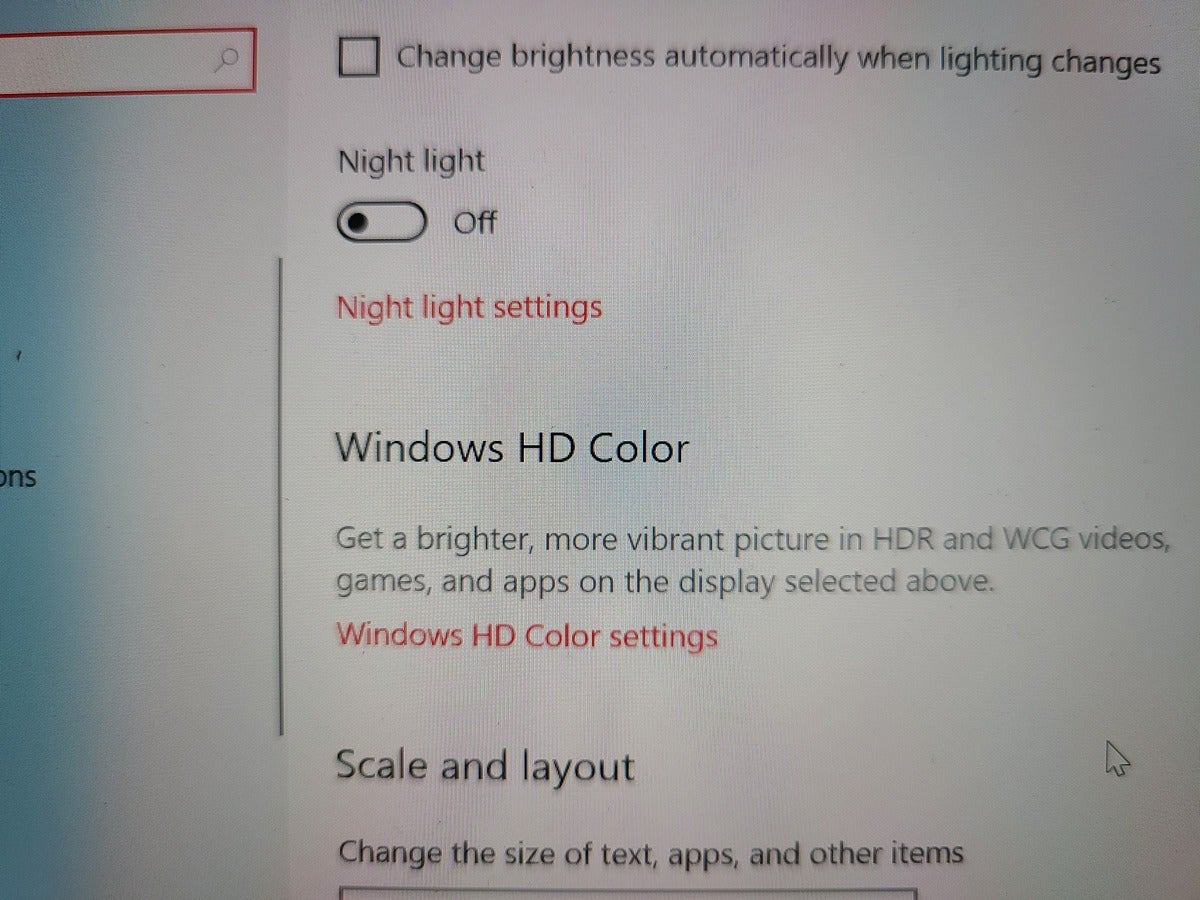 Mark Hachman / IDG
Mark Hachman / IDG
Microsoft’s 10.5-inch Surface Go 2 at the default resolution of 1800 x 1200, at 150 percent scaling.
Weirdly, I was most conscious of the Surface Laptop Go’s display when I connected to my home’s 4K monitor, and not because the Laptop Go had any technical issues. Microsoft’s low-res Surface Laptop Go wallpaper—a fever dream of cotton-candy shag carpet and sand—looked even worse in 4K.
 Mark Hachman / IDG
Mark Hachman / IDG
This is an image captured from the 14-inch HP Pavilion x360 Convertible 14, with a 14-inch, 1080p display.
The display options are an area of compromise. You can use the USB-C port to connect to a single external 1080p display without issue, but if you need an HDMI port you’ll probably need to attach a USB-C hub that includes it. If you want to get fancier—I like to have two displays attached to my laptop—My Surface Laptop Go connected easily to my 4K display and a separate 1080p monitor at full resolution, but only thanks to the first-generation $175 Surface Dock I happened to have on hand, along with a pair of miniDP-to-HDMI cables. Via a USB-C hub, the Surface Laptop Go limited my 4K display to a subpar 24Hz refresh rate. I had to manually force it to 30Hz, still far inferior to the preferred 60Hz frequency.
 Mark Hachman / IDG
Mark Hachman / IDG
This is the same image captured on the display of the Surface Laptop Go. Click to zoom in.
Surface Laptop Go keyboard: Same difference
If you’ve ever used a Surface keyboard, there’s a resilient springiness that tends to carry over from one Surface device to another. The Surface Laptop Go feels somewhat like a traditional Surface keyboard, and Microsoft says it retains the 1.3mm of key travel of the Surface Laptop 3 and Surface Laptop 2. I perceived a very plasticky feel to the keys, but Microsoft says the only change is the paint atop the keyboard resin. They’re certainly very comfortable to use. Unfortunately, there’s no keyboard backlighting, however.
 Mark Hachman / IDG
Mark Hachman / IDG
A large, slick trackpad dominates the Surface Laptop Go’s keyboard.
Microsoft included a Precision touchpad in the Surface Laptop Go, and it, too has its quirks. I’ve never felt a touchpad so slick, to the point that I’m not sure it always registered my fingers when they slid across the surface. It’s clickable all the way to the top, though with more pressure required as you move upward.
We’ve seen Microsoft Surface devices yield unexpectedly powerful audio from their internal speakers, and the Surface Laptop Go aspires to that standard. While Dell’s Latitude 9510 and recent XPS notebooks produce astoundingly rich, resonant audio, the Surface Laptop Go falls neatly in the category of “good”—a solid mix of midrange and high-end, and even adequate bass. Some Surface devices, like the Surface Book line, ship with Dolby Atmos audio enhancement. The Laptop Go does not, though the dual Omnisonic speakers are Dolby-enhanced. Headphones are still advised, but if you or your child has to play back video, listen to Spotify, or some other audio file on the Laptop Go’s internal speakers, no one will complain.
The Surface Laptop Go includes a 720p user-facing camera, a step down from the excellent 1080p cameras built into other Surface devices. To be fair, a 720p camera is par for the course in the laptop space, and Microsoft’s cameras (RIP, Lumia) still produce a decent, color-accurate image. Your Zoom calls should look fine. Like other Surfaces, however, Microsoft left out a sliding camera shield or dedicated button to turn off the laptop’s microphone. Two far-field mics help pick up your voice.
 Mark Hachman / IDG
Mark Hachman / IDGPerhaps because of the default Windows 10 in S Mode operating system, the Surface Laptop Go is spectacularly bloat-free: no pre-installed Candy Crush or any of that nonsense. Spotify is perhaps the only third-party app on the machine. Microsoft includes a 30-day trial of Microsoft 365 Family.
Microsoft has a new app for you, too: the Surface Diagnostic Toolkit. While this appears to be a utility for ferreting out potential problems with your Surface, it also sums up the Surface Laptop Go’s general features and provides a link to support and warranty information. It even has a neat little battery utility that can track how many charge cycles your battery has gone through, along with other basic information.
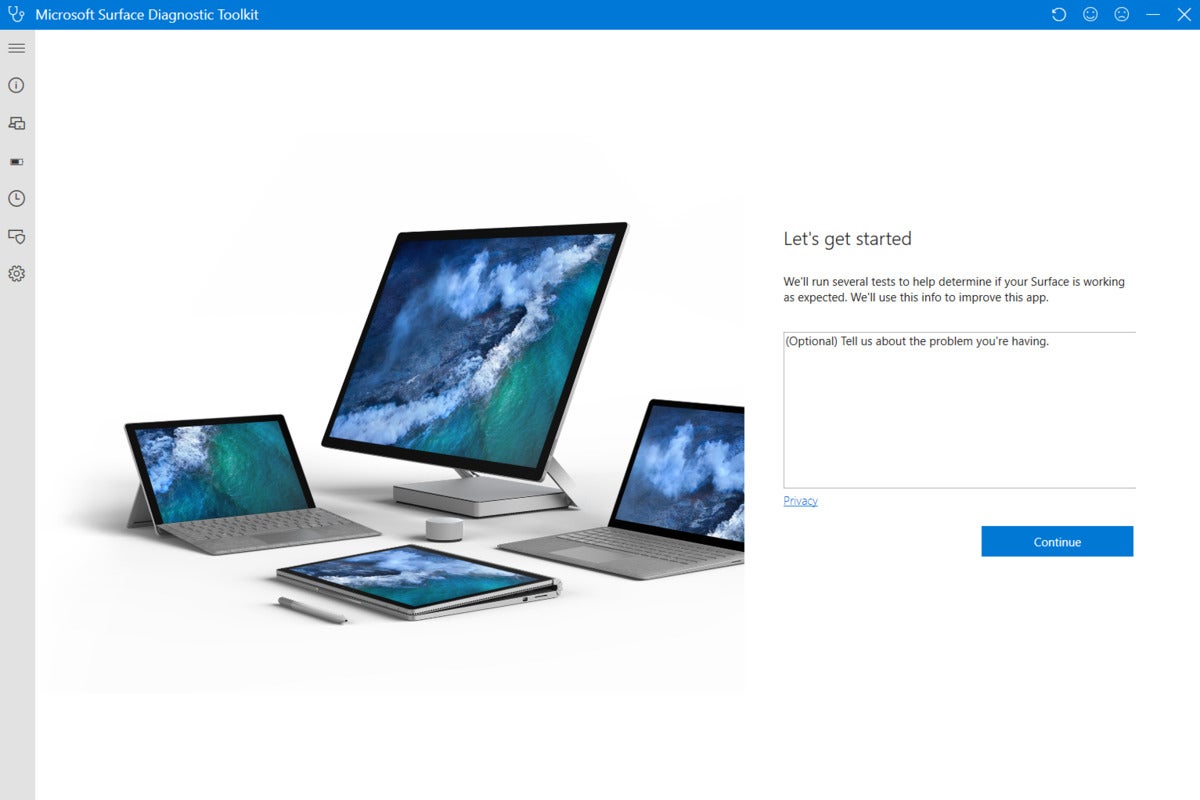 Mark Hachman / IDG
Mark Hachman / IDG
Microsoft’s Surface Diagnostic Toolkit app appears to have replaced the Surface app, and provides a summary of the Surface Laptop Go’s specs, along with diagnostic tests.
What Windows 10 in S Mode means for you
Microsoft’s Surface Laptop Go ships with Windows 10 in S Mode (aka Windows 10 S), a signal that Microsoft wants the Surface Laptop Go to compete with Chromebooks as simple, managed devices. S Mode’s inherent tradeoff is that to prevent an unauthorized application or malware from attacking your PC, the operating system limits app downloads only to those found within the Microsoft Store. Even some Windows apps like the Command Shell are prohibited. (An “app” that is also available as a webpage, like Facebook, can also be saved to the Start menu.) This also prevents services like antivirus software from running, which is somewhat less of a concern given that Microsoft only allows Microsoft-approved apps on your PC.
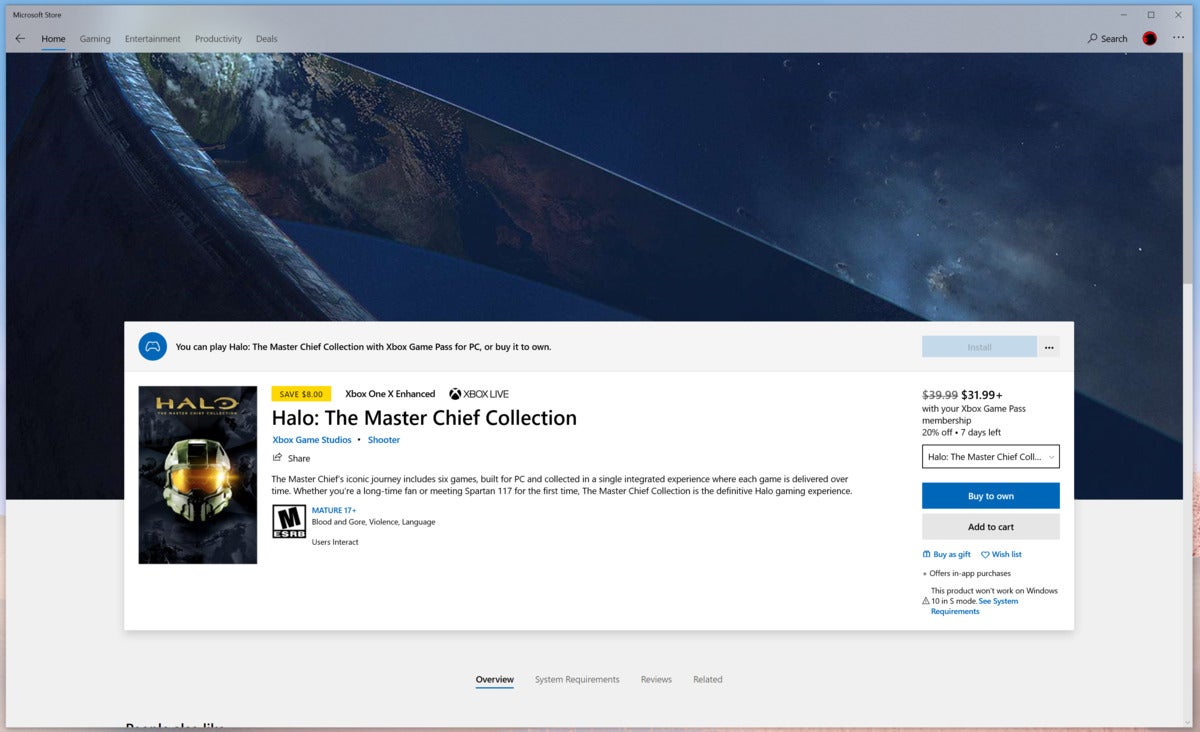 Mark Hachman / IDG
Mark Hachman / IDG
Part of the frustration of working with Windows 10 S is Microsoft’s refusal to filter out apps that won’t run on its operating system. See the tiny note to the lower right?
The inherent frustration with Windows 10 S is the same as when working with Windows on ARM: Chances are there will be some small, necessary app that you’ll absolutely need, and won’t be able to use.
Equally infuriating is Microsoft’s inability to put basic filtering on the Store itself. When you launch the Microsoft Store app, you’ll see every app available to Windows 10 PCs. But the Surface Laptop Go isn’t a full-fledged Windows 10 PC. Many apps you might want have a grayed-out “Install” button, and a tiny note explaining that the app isn’t compatible with Windows 10 in S Mode. We don’t understand why Microsoft can’t only show you apps your PC can download.
That said, there’s a decent amount of apps and games that are available for the Surface Laptop Go: the Office suite, certainly, as well as popular apps like Spotify. But even games are hit-and-miss: Minecraft for Windows 10 is Windows 10 S-capable. Minecraft Dungeons is not. Halo? Nope—even though all three are Microsoft-owned games. Meanwhile, third-party games like World of Tanks: Blitz and Goat Simulator are ready to rock.
As you may be aware, however, there is a way out. Within the Windows 10 Settings menu (Update & Security > Activation) lies the Switch to Windows 10 Home option. Switching out of Windows 10 in S mode to Windows 10 Home is a one-way street, and you’ll lose the protective embrace of Windows 10 S. Doing so, however, opens the door to all the freedom you’d expect with a PC.
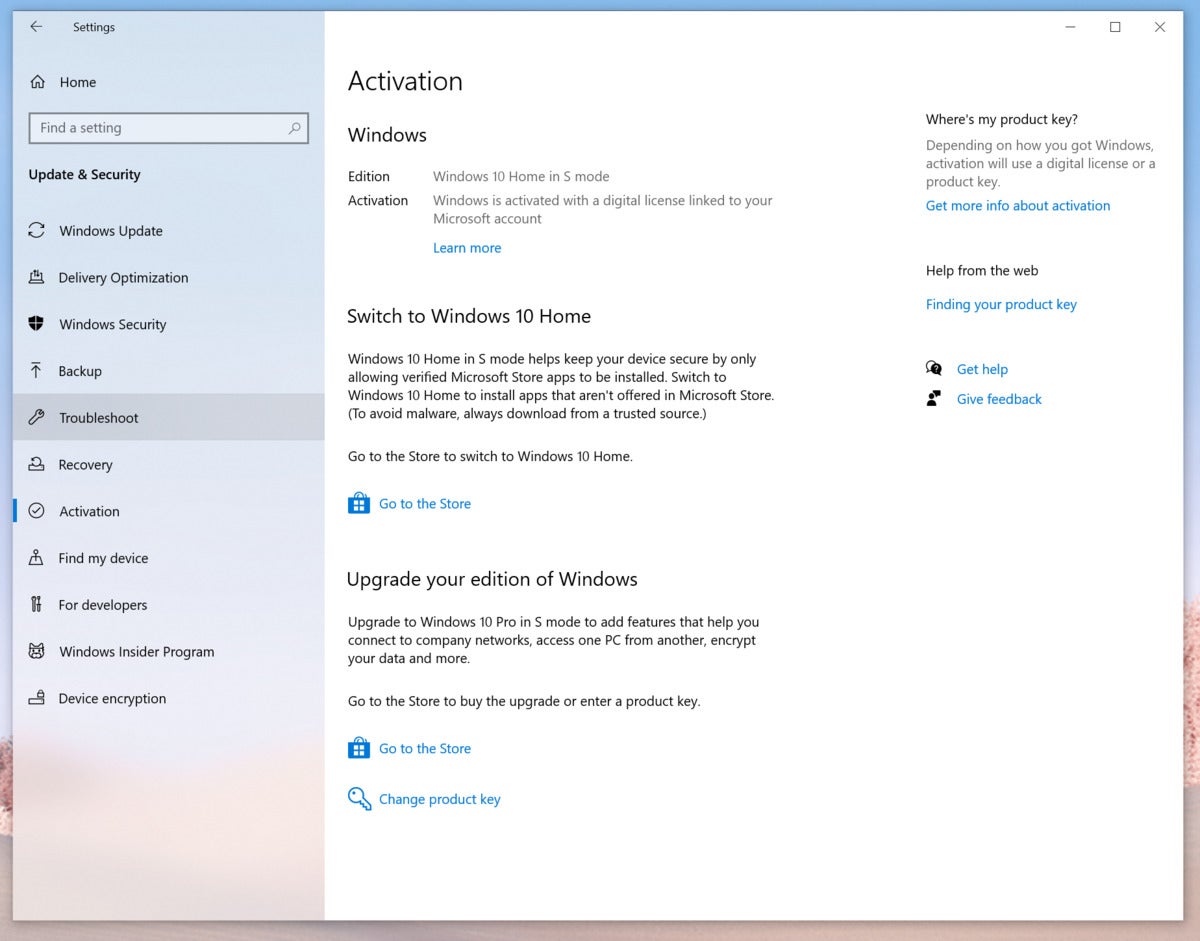 Mark Hachman / IDG
Mark Hachman / IDG
You can switch out of Windows 10 in S Mode in favor of Windows 10 Home, for free. The process takes literally just a few seconds.
Battery life is one slightly brighter spot for Windows 10 in S Mode. We’ve noticed longer life from prior Surface Laptops tested in S mode, although the margin seems to have narrowed over time. The Surface Laptop Go’s battery lasted a little longer in S mode than in it did when we switched to Windows 10 Home, but not enough to justify sticking with the more limited operating system.
Performance: Windows 10 in S Mode
Because the Store restrictions prevented us from running our traditional suite of benchmarks in Windows 10 S, we used browser-based benchmarks for comparison. We ran several tests comparing various products, mostly from Microsoft. (Skip ahead for our tests running Windows 10 Home on a broader suite of devices.)
From a real-world perspective, the WebXPRT tests are meaningful, both the current WebXPRT 3 as well as the older WebXPRT 2015. Both perform similar tasks: graphing data, manipulating and tagging photos, and similar, relatively modern Web-based activities. We have a large database of WebXPRT scores, though the developer, Principled Technologies, has also published a Chromebook-specific version. Unfortunately, it requires ChromeOS to run. The Surface Laptop Go posted a good upper-middle score against the competition.
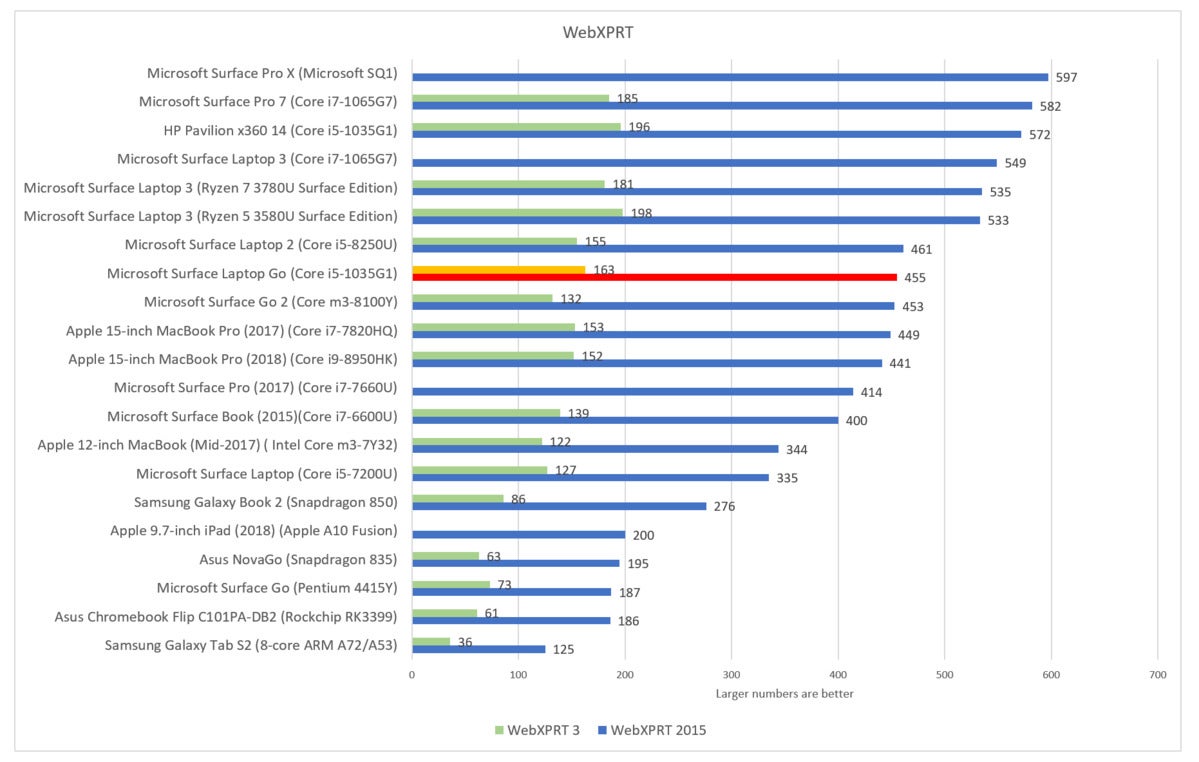 Mark Hachman / IDG
Mark Hachman / IDG
By this measure, Microsoft’s Surface Laptop Go does decently, proving that it should be perfectly capable in Web apps.
The JetStream benchmark measures a browser’s performance on JavaScript and WebAssembly and “rewards browsers that start up quickly, execute code quickly, and run smoothly,” according to the developers. We’re testing hardware, not browsers, here, and there’s some variation—some of these tests were performed under Chrome and the legacy Edge browser, both of which have evolved over time. Still, it’s a decent measure of Web performance—and if you consider these as Chromebook competitors, they’re an important benchmark, too. Here, the Surface Laptop Go landed right in the middle.
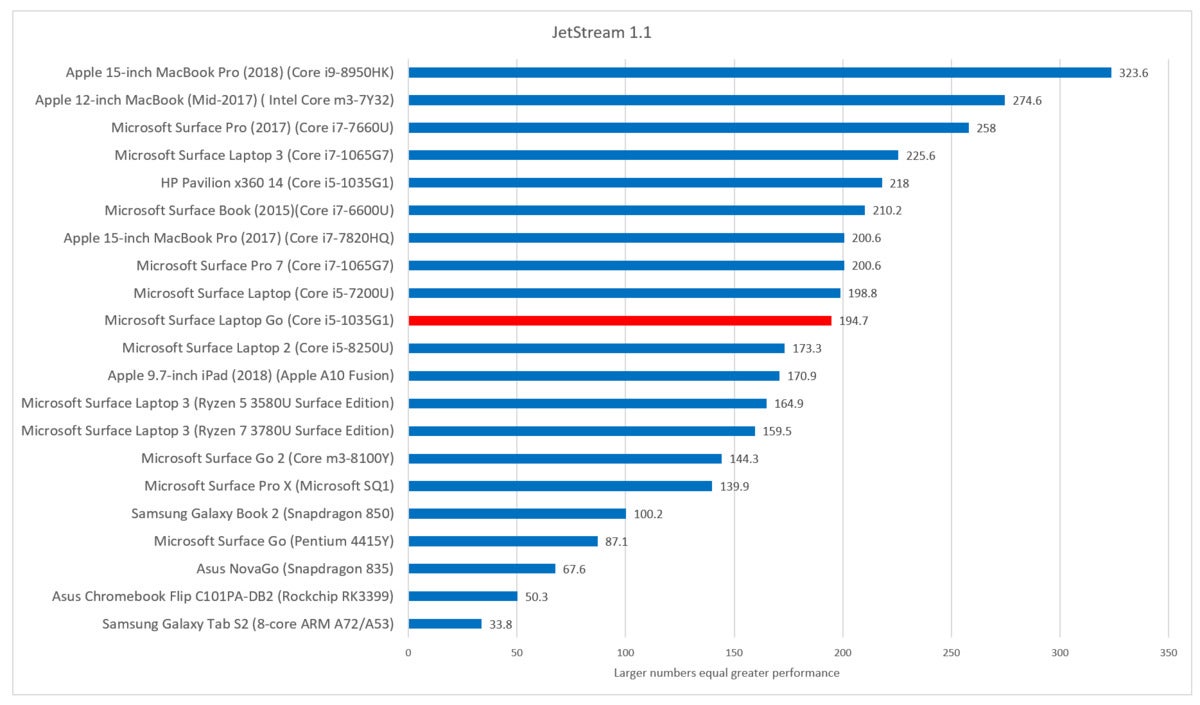 Mark Hachman / IDG
Mark Hachman / IDG
As in many of these benchmarks, the Surface Laptop Go performs adequately.
The Speedometer benchmarks measure the responsiveness of Web applications, using demo web applications to simulate user actions such as adding to-do items. The Surface Laptop Go posted one of the highest scores in this test.
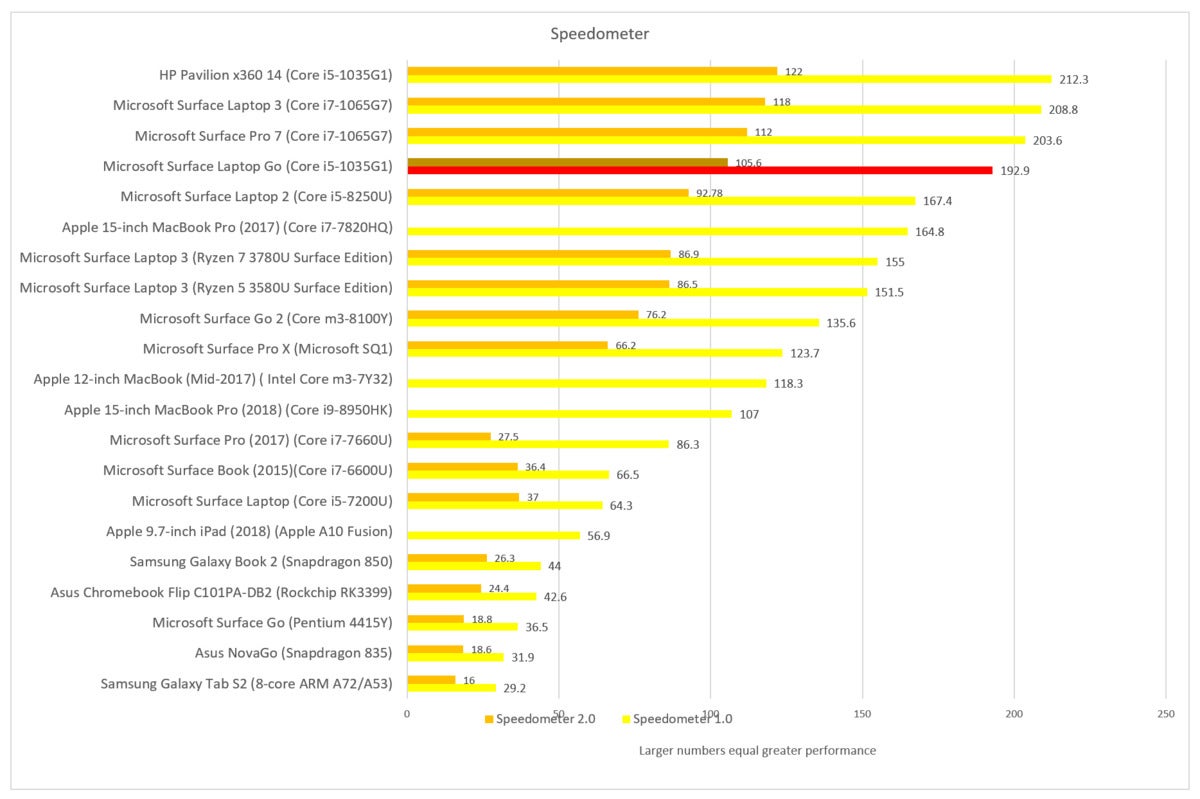 Mark Hachman / IDG
Mark Hachman / IDG
Good news: the Surface Laptop Go finishes in the upper third here.
I played the pair of games mentioned earlier to get a sense of how the Surface Laptop Go will run outside of Web browsing and Office apps. Goat Simulator, a playful “destroy everything” simulator, was playable with all detail turned down to minimal levels. World of Tanks Blitz, a simple tank simulation also available for Android tablets, ran at a smooth 60 fps at Medium settings. (Weirdly, neither game allowed you to set the resolution.)
Performance: Windows 10 Home
In the real world, the Surface Laptop Go is absolutely suitable as a classroom/study-from-home PC. I used it for several days as an ordinary work laptop, with Zoom and Teams calls, streaming video, messaging coworkers, and the like. It was a pleasure to use.
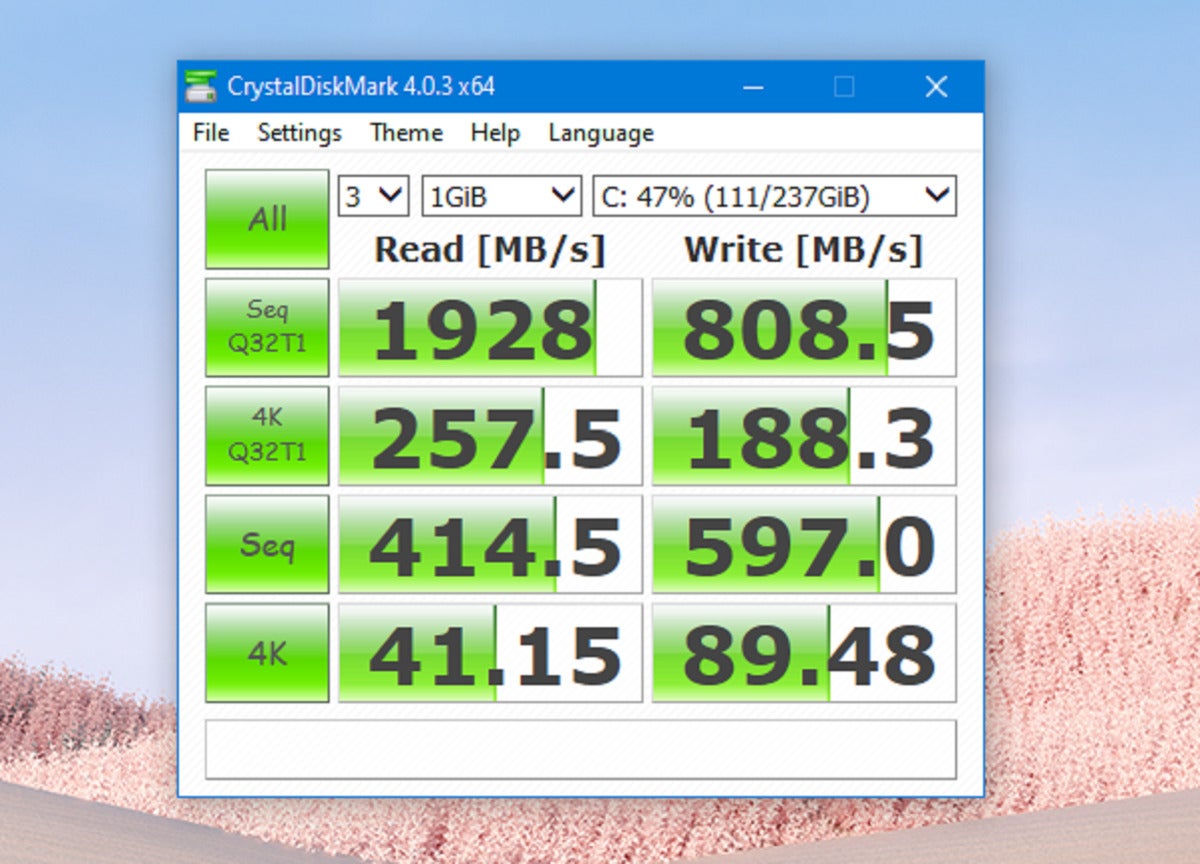 Mark Hachman / IDG
Mark Hachman / IDG
CrystalDiskMark measures how well the Surface Laptop Go SSD performs: surprisingly, pretty well, especially in sequential reads. Unfortunately, the Surface Laptop Go’s SSD does not appear to be user-accessible at all.
After I switched out of S Mode, the door opened to our normal collection of benchmarks. We use UL’s PCMark 8 tests as an older benchmark showing off the Surface Laptop Go’s ability to perform tasks like word processing, data manipulation within spreadsheets, videoconferencing, and so on. These tests are measured by the PCMark 8 Work suite. We also use the Creative test suite to add in light and mainstream gaming, and more intensive photo and video manipulation. The Surface Laptop Go landed in the middle among its competition.
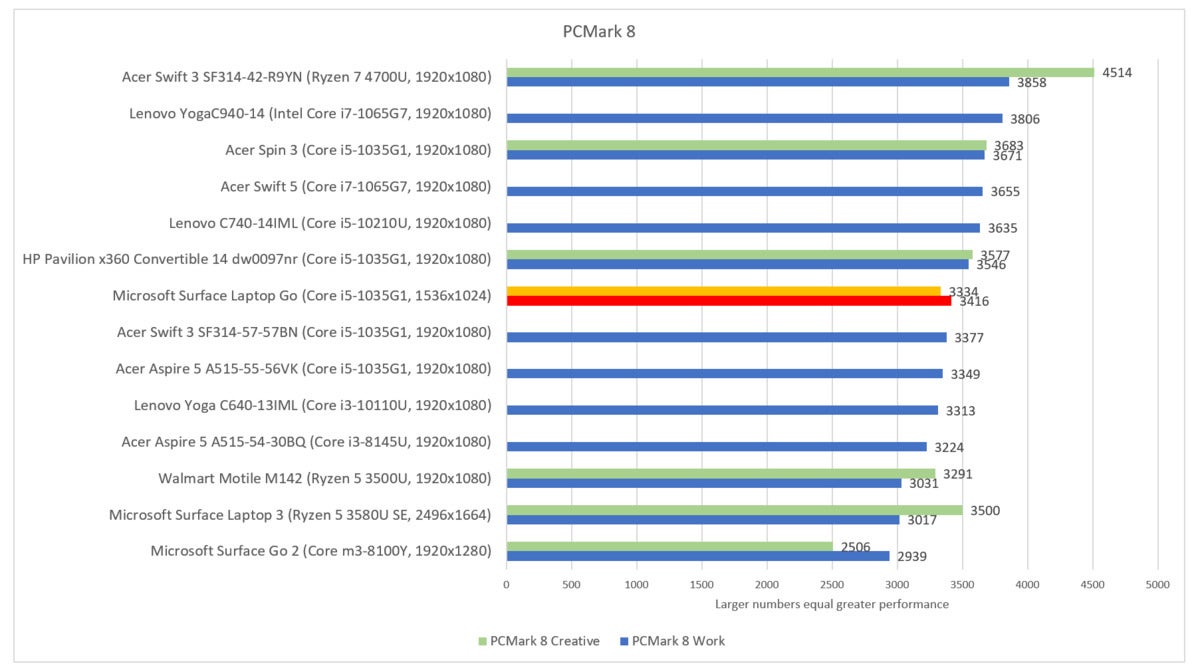 Mark Hachman / IDG
Mark Hachman / IDG
In the typical office and light gaming applications measured by PCMark, Microsoft’s Surface Laptop Go holds its own.
Maxon’s Cinebench benchmark stresses all four cores and eight instruction threads of the Surface Laptop Go’s Core i5 processor, assigning each thread a small portion of a complex 2D image that the software renders. We use this as a test to measure short, bursty workloads. The Surface Laptop Go stumbled in this test, registering one of the lowest scores of the bunch.
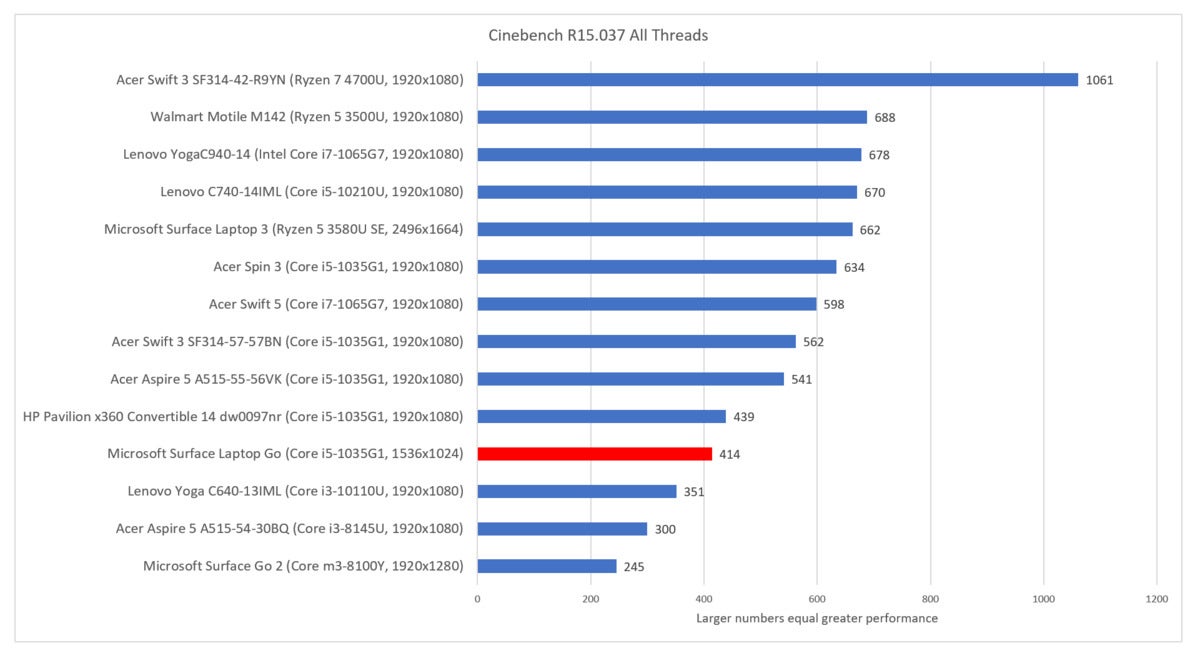 Mark Hachman / IDG
Mark Hachman / IDG
The Surface Laptop Go finishes surprisingly far down in this basic measure of CPU performance.
The HandBrake benchmark is the opposite of the Cinebench sprint. The process of transcoding a Hollywood movie executes over time—more than an hour, in this case —providing a view of how the laptop handles prolonged loads. Processing power matters here, but also how cool the laptop remains while it’s working. Our score is the time, in seconds, the conversion needs to complete, and shorter is better. The Surface Laptop Go brought up the rear of the middle, adequate but not outstanding.
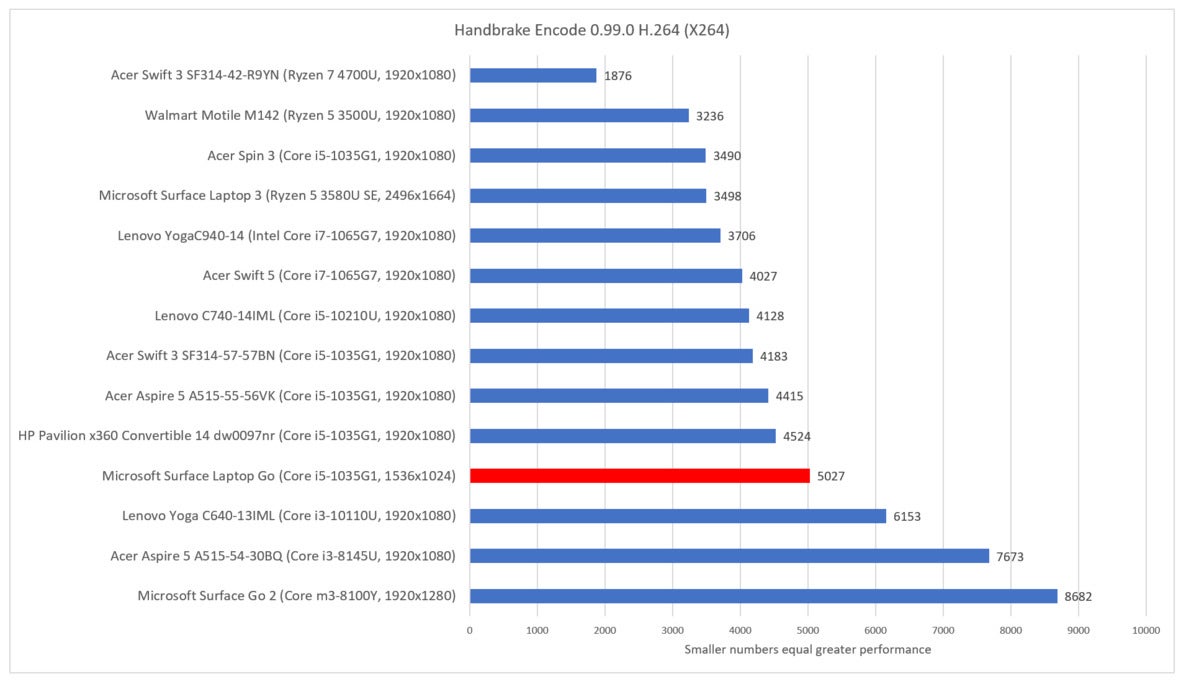 Mark Hachman / IDG
Mark Hachman / IDG
Again, this test proves that the Surface Laptop Go is not a computing powerhouse.
Numerous 3DMark benchmarks exist to test the graphics capabilities of laptops and their (in this case) integrated GPUs. We use the Sky Diver benchmark, specifically designed for integrated graphics. The Surface Laptop Go’s UHD graphics isn’t up for much, so the midrange score is actually good.
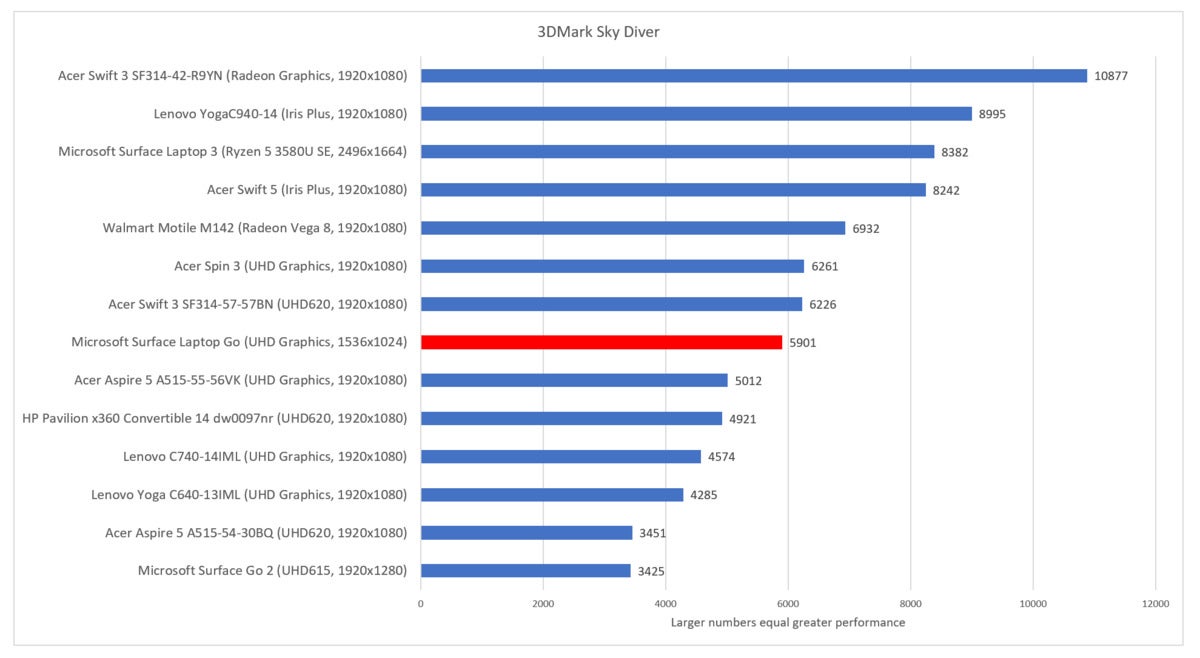 Mark Hachman / IDG
Mark Hachman / IDG
In terms of graphics, the Surface Laptop Go finishes in the middle of the pack.
Finally, there’s battery life. We loop a 4K video over and over until the laptop’s battery expires. It should be noted that Microsoft’s own battery-life tests assume a screen brightness of 150 nits, far lower than what we consider to be adequate brightness levels.
For its size, the Surface Laptop Go performs competently, at 495 minutes (8 hours, 15 minutes) in Windows 10 Home. We tested battery in Windows 10 S mode before we switched, and it was a little better at 521 minutes (8 hours, 41 minutes). If that doesn’t cut it, the Surface Laptop Go includes quick charging, which Microsoft says will charge the battery to about 80 percent in an hour. Windows’ battery meter showed the Laptop Go charging from 4 percent to 54 percent in about an hour, and from 4 percent to 82 percent in about 90 minutes.
 Mark Hachman / IDG
Mark Hachman / IDG
Battery life of eight hours and fifteen minutes isn’t bad, especially if you’ll mostly use the Surface Laptop Go at home.
Conclusion: Good, not great
Microsoft’s Surface Laptop Go is a solid budget laptop reaching for good rather than great. Until Intel and its partners manage to push its 11th-gen Tiger Lake notebooks out the door, this really is the time of AMD’s mobile Ryzen. A laptop like our Editor’s Choice-winning $655 Acer Swift 3-SF314-42-R9YN is still available, and even some grumbling about thermals on Amazon’s product page shouldn’t turn you off. Walmart’s Motile M142, at $500, was also surprisingly good. Acer’s Spin 3 offers a third choice, which you can buy from Costco for $650. It too, outperforms the Surface Laptop Go, and for a lower price.
All of our reviews linked above are worth reading carefully as part of your buying research. At the premium Microsoft charges, we’d recommend the $699 8GB RAM/128GB SSD configuration instead of our review configuration.
Microsoft touts the Surface Laptop Go as the “everyday, everywhere” laptop, implying that you would be better off buying the Laptop Go than a Chromebook. I still believe that Microsoft has it in them to develop the “everyday, everywhere, everyone” laptop. With the Surface Laptop Go, Microsoft is headed in the right direction.
Updated at 2:00 PM on Oct. 13 to add the Surface Laptop Go’s rated screen brightness.

